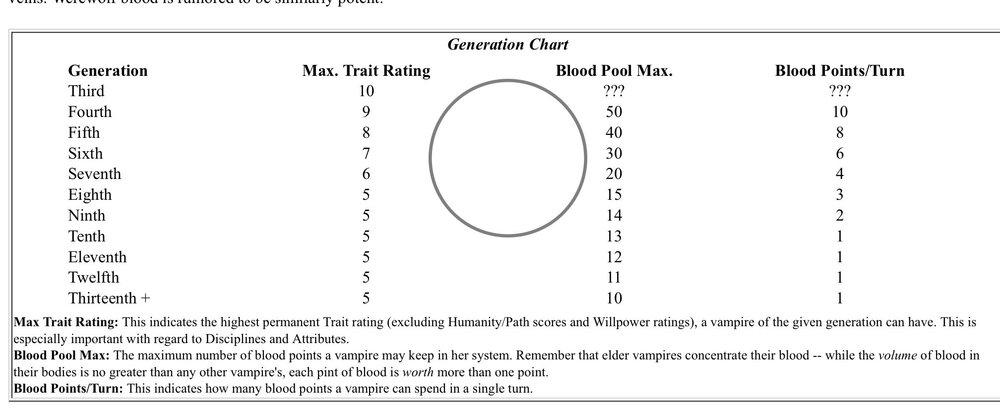Hello, I developed a conversion to use the VtM (3rd) edition setting in genesys .
My historic game group and I always loved the setting but when we tried to play (in the early 2000s) all three campaigns were aborted a handful of sessions after character creation, smothered by the buckets of dice and the quirky rules. We are having a lot of fun playing, including the two players new to the system (one of them was also new to the setting).
The pdf file can be found at
this address (Dropbox)
. I am completely unable to use GMbinder et similia, so the file is presented in a very simple word->pdf format. I really regret not been comfortable with graphics. The document does not even include backgrounds or images.
![]()
The first version of these rules was written 6 months ago (January 2019) and we have been playing in a chronicle (4 players plus myself) since (for a total of more or less 20 sessions so far), tuning costs and effects as result of playtesting. However, a few players in the group are new to the system, and obviously not all Clans and disciplines have been explored fully, therefore I much appreciate any feedback , whether it comes from play testing or simple theoretical criticisms.
This document includes
- Archetypes (Clan)
- Careers and modified skills
- Vampiric talents
- Disciplines (distinguished from talents and skills)
- Miscellaneous rules (Hunting, Feeding, Vitae, Strain and Damage Management, Frenzy)
- Thaumaturgy and Necromancy rules
Some notes:
- While there is some flavor text, I did NOT describe the setting in general in the document . These rules are intended for GMs and players who already know at least vaguely about the Masquerade, the Camarilla, the Sabbat, etc.
- The biggest rule change (beside the necessary adaptation) is the reduction of clan disciplines from 3 per clan to 2 per clan .
- Consequently, certain disciplines (Vicissitude, Celerity, Quietus, Serpentis) have been transformed into tiered restricted talents that try to capture what (IMHO) was fun and intriguing about each clan and discipline. All of this also allowed me to rebalance Celerity into a strong but not god-like combat "discipline", which used to be a common complaint about the balancing of the game.
- Thaumaturgy and Necromancy have also been reimagined as magic rather than technical disciplines.
- Fortitude and potency have been rolled into one . Another significant change, but that goes together with 2), and preserve the feeling that Clans with access to one or the other are dangerous in combat situations.
- I am extremely pleased with the results we had with the Hunting-Feeding streamlined mechanism . I was skeptical but it ended up being quickly resolved every time while still providing a plethora of story-moments, some of which sprawled into sub-plots in typical genesys fashion. Viceversa, I am not enthusiastic about the Frenzy mechanism .
- While I tried to stay true to the original Clan's flaws, some where reimagined to work more precisely. The Tzimisce's flaw was changed into a Dracula-inspired one, a variant that was popular in various WoD forums back in the days.
- Vitae has been kept as a consumable resource . Since Vampires literally replenish themselves with blood I couldn't see any way to keep it elegantly in line with Strain and Wounds (which grow up to a threshold.
- I have not included any enemy profile . I am working on Hunters rules, but they are very much in a development stage.
- There is no list of weapons , we used stuff from the modern setting of the core book.
- I took some liberties with a couple of structural rules (namely doing away with concentration and creating skill checks that include challenge dice by default)
I don't plan to revise the rules for another few months (since I want to start working on a Post-Apocalyptic and/or a SteamPunk-meets-Strange&Norrell kind of settings), but I will be checking this thread and responding to any question (and drinking in any feedback).
Thank you
Geki
Edited by geki